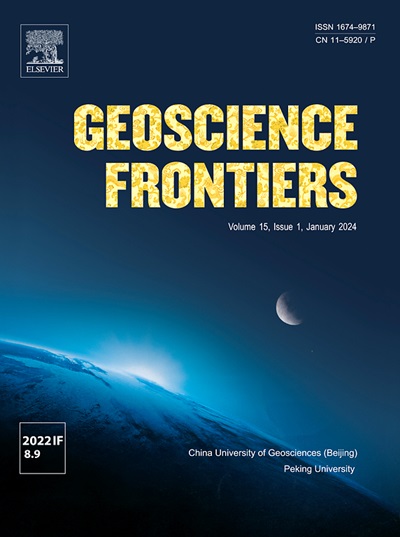Detrital zircons from Cambrian rocks of western Laurentia define two episodes of Rodinian rift-related magmatism
IF 8.5
1区 地球科学
Q1 GEOSCIENCES, MULTIDISCIPLINARY
引用次数: 0
Abstract
Many aspects of the disassembly of Neoproterozoic supercontinent Rodinia remain poorly constrained. Current models for the breakup along western Laurentia (present coordinates) do not fully reconcile stratigraphic observations regarding the timing and mechanisms of continental rifting. Latest Neoproterozoic to Cambrian stratigraphic units exposed along the North American Cordillera from southwestern Canada to the southwestern United States contain Neoproterozoic and Cambrian zircons interpreted to be sourced from rift-related igneous rocks generated during the fragmentation of Rodinia. Two discrete magmatic episodes distinguished by a ca. 50 Myr period of apparent magmatic quiescence are identified using the detrital record: (1) Tonian and Cryogenian to earliest Ediacaran magmatism (mantle plume events followed by rifting); and (2) latest Ediacaran to late Cambrian magmatism. The detrital zircon record of the first episode supports a 660–650 Ma rift-to-drift transition followed by passive margin sedimentation of the upper Windermere Supergroup. After a period of apparent magmatic quiescence from 630–580 Ma, detrital zircon dates of 580–520 Ma from central-western Laurentia provide evidence for renewed rift magmatism preceding the initiation of the lower Paleozoic passive margin. These new U-Pb dates are used to present a refined model of Rodinia disassembly with improved timing constraints suggesting that its final breakup and the Sauk I transgression occurred ca. 520 Ma, in accordance with recent revisions to the timing of the Sauk transgressions in southwestern Laurentia.

劳伦西亚西部寒武系碎屑锆石确定了两期罗丁期裂谷相关岩浆活动
新元古代罗丁尼亚超大陆的解体在许多方面还没有得到很好的研究。目前沿西劳伦西亚断裂的模型(现在的座标)不能完全与关于大陆裂陷的时间和机制的地层观测相一致。从加拿大西南部到美国西南部,沿北美科迪勒拉暴露的最新的新元古代到寒武纪地层单元含有新元古代和寒武纪的锆石,这些锆石被解释为来自Rodinia碎裂期间产生的与裂谷有关的火成岩。根据碎屑记录,确定了两个离散的岩浆活动期,以约50 Myr的明显岩浆静止期为特征:(1)东、低温期至最早埃迪卡拉纪的岩浆活动(地幔柱事件之后是裂谷运动);(2)晚埃迪卡拉-晚寒武世岩浆活动。第一阶段的碎屑锆石记录支持660-650 Ma的裂谷-漂移过渡,随后是上温德米尔超群的被动边缘沉积。在经历了630-580 Ma的明显岩浆静息期后,Laurentia中西部580-520 Ma的碎屑锆石日期提供了下古生代被动边缘形成之前裂谷岩浆活动恢复的证据。这些新的U-Pb年代被用来提出一个改进了时间约束的Rodinia解体模型,表明它的最终解体和Sauk I海侵发生在520 Ma左右,与最近对Laurentia西南部Sauk海侵时间的修正一致。
本文章由计算机程序翻译,如有差异,请以英文原文为准。
求助全文
约1分钟内获得全文
求助全文
来源期刊

Geoscience frontiers
Earth and Planetary Sciences-General Earth and Planetary Sciences
CiteScore
17.80
自引率
3.40%
发文量
147
审稿时长
35 days
期刊介绍:
Geoscience Frontiers (GSF) is the Journal of China University of Geosciences (Beijing) and Peking University. It publishes peer-reviewed research articles and reviews in interdisciplinary fields of Earth and Planetary Sciences. GSF covers various research areas including petrology and geochemistry, lithospheric architecture and mantle dynamics, global tectonics, economic geology and fuel exploration, geophysics, stratigraphy and paleontology, environmental and engineering geology, astrogeology, and the nexus of resources-energy-emissions-climate under Sustainable Development Goals. The journal aims to bridge innovative, provocative, and challenging concepts and models in these fields, providing insights on correlations and evolution.
 求助内容:
求助内容: 应助结果提醒方式:
应助结果提醒方式:


